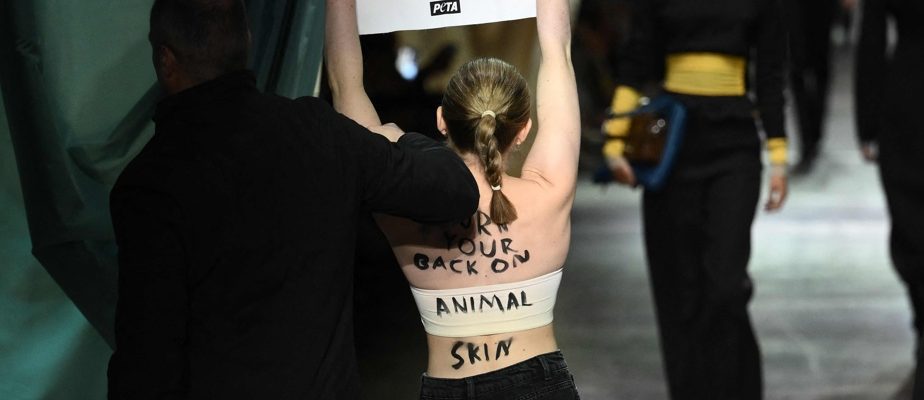(Milan) All the rage this week at Milan Fashion Week: animal rights activists have launched an attack on brands that have not yet given up on fur, hoping to convince Italian labels Max Mara in particular. and Fendi.
An activist from the animal rights association PETA took to the Fendi catwalk on Wednesday, brandishing a sign “Animals are NOT clothes”. And a coalition of pro-animal groups stepped up their campaign against Max Mara on Thursday.
More than 1,500 clothing brands, including some of the most prestigious, have turned their backs on fur in recent years, but others are resisting.
On Thursday, for the second day in a row, a hot air balloon bearing the message “Max Mara Go Fur-Free” flew over the company’s headquarters in Emilia-Romagna.
This operation is supported by the Fur Free Alliance – a coalition of more than 50 animal protection associations, including the Humane Society International and the Italian Anti-Vivisection League LAV – which has been targeting Max Mara since the beginning of the month.
The campaign, which includes demonstrations, publications on social networks, telephone calls and emails, coincides with the season of Fashion Weeks in New York, London, Milan and Paris which follow one another until March 5.
Max Mara, whose fashion show on Thursday was fur-free, did not respond to requests from AFP.
Unlike Fendi, which began as a fur brand, Max Mara is best known for its luxurious wool and camel hair coats, occasionally using fur as trim on hoods and cuffs.
The brand could do without fur, argues Simone Pavesi of LAV to AFP. “It’s really a problem of total indifference, they could resolve it from one season to the next,” he believes, regretting that the company refuses to discuss with the associations.
Outside the Max Mara show, 32-year-old fashionista Anna Kirichenko sports a black ski hat emblazoned with the company’s logo, paired with an oversized black faux fur jacket: “There are so many alternatives ( (real fur) I don’t like the smell of death,” she snaps.
At Fendi, Elke Orth, a 21-year-old fashion student, believes that big brands still using fur have considerable influence, even if young people’s attitudes have changed.
“They have a lot of power because everyone wants to be part of this universe. But if a famous actor or singer said, ‘I’m not going to this parade,’ that would cause a big change,” she says.
Gassed or electrocuted
Gucci, Versace, Armani, Prada, Valentino, Dolce & Gabbana are among the houses that have given up on fur.
In France, the main holdouts are Louis Vuitton and Hermès.
Activists cite the cruelty inherent in fur farming, where foxes, mink, chinchillas, rabbits and raccoon dogs are crammed into battery cages before being gassed or electrocuted.
Undercover operations have highlighted the deplorable conditions of these farms, with sick and stressed animals, as well as self-mutilation and infections.
However, the sector claims to be virtuous for the environment, which is rejected by anti-fur activists, for whom the carbon footprint of farms is higher than the production of synthetic fur.
Although 17 EU countries adopted total or partial bans on farming in December, and others are preparing to do so, the sale of fur is not prohibited there, which is however the cases already in Israel, the state of California and certain American cities.
The European Commission must nevertheless decide by March 2026 on a possible ban on fur farming and sales. It could also choose to adopt “appropriate rules” to respect animal welfare.
According to the LAV, Max Mara has been blocking hostile comments on his Instagram account since Wednesday. “We are not interested in a pressure campaign. We prefer to speak with the company, explain our reasons… and convince them to stop using fur,” argues Simone Pavesi.
